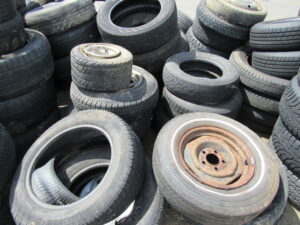Tire Recycling – Explained
On Saturday, April 27th, DPW will be hosting its annual Tire Drop Day at our recycling and composting facility located at 65 Witchtrot Road from 9 a.m. to 4 p.m. No registration is required for this event but residents do need to have a permit to use the facility which can be purchased at the clerk’s office at Town Hall.
Residents often ask us about this event and what happens to the tires that are collected. When tires become unsuitable for use they are typically recycled and can be processed into ground rubber, asphalt additives, and even fuel.
DPW partners with BDS Tire Recycling who specialize in scrap tire collection, transportation, storage, and recycling for customers throughout New England. They process all the scrap tires they collect at a licensed facility in Maine. All resulting products are utilized in accordance with Maine DEP and US EPA rules and regulations. Examples of product usage include tire-derived fuel (TDF), landfill drainage material and lightweight fill material in civil engineering projects.
Once at the BDS facility the tires are unloaded and separated. Tires without rims and tires small enough to be shredded whole are fed directly into a shredder with a hydraulic excavator. Tires with rims are placed in a pile to have the rims removed with an excavator-mounted shear. The de-rimmed tires are then placed in a pile where they are fed directly into the shredder. Steel and aluminum rims are recycled as scrap metal.
Once the tires are shredded the shreds are conveyed over a classifier that classifies the shreds into 6″ minus and 6″ and over. The 6″ and over are recirculated back into the shredder and continue in this process until the shreds are small enough to pass through the classifier as a Type B chip. The Type B chips are then conveyed into a finished Type B chip stockpile.
For more information about BDS Tire Recycling, go to www.bdswastedisposal.com.
Why dispose of scrap tires?
Apart from being unsightly, used tires provide a breeding place for mosquitos, homes for rodents, snakes, and ticks, and the rubber can pollute ground water with toxins if put into the ground.According to a report by the Tire Industry Project for the World Business Council for Sustainable Development, 1 billion end-of-life tires are generated every year and there are currently 4 billion such tires in landfills and stockpiles worldwide.
What can be made with recycled tires?
- Rubber floors. Rubber flooring has gained much popularity over the years due to its wide variety of designs and colors and the fact that it lasts up to 30 years attracts many people. Such floors don’t have to be waxed, as the material is nonporous and no special products are needed to clean such floors.
- Rubberized asphalt. The ground rubber made from recycled tires can be added to asphalt to improve roads. Rubberized asphalt helps prevents road damage, saving money on maintenance and the material is also noise-absorbing, so road noise can be reduced by as much as seven decibels.
- Playground elements. Rubber absorbs shock from collisions, which makes it a perfect material for matts, running tracks, and playground equipment. Recycled car tires are clean, money-saving, durable, and require little maintenance; they can also be easily installed over any other material used previously.